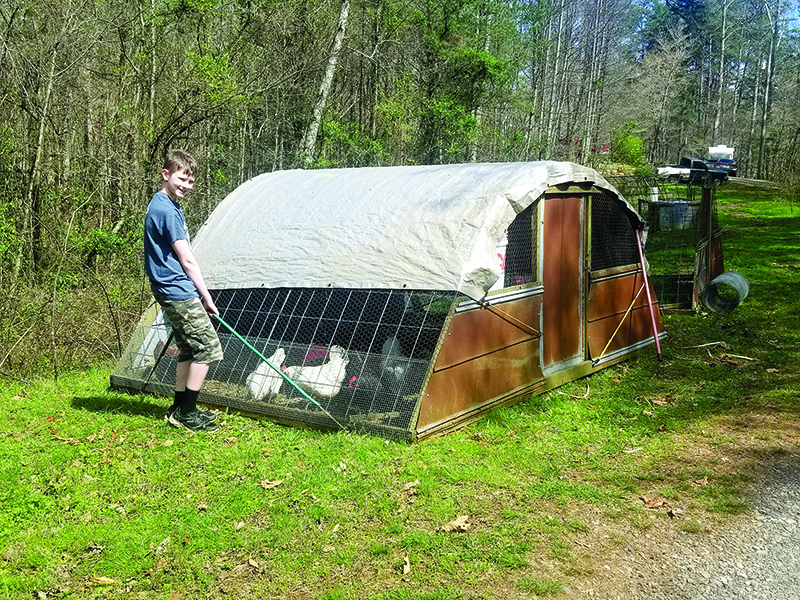‘Little ways to have joy when everything else around you is harsh’
For Joey and Sabrina Sullivan, mealtime is one of the main benchmarks they use for determining how well their homestead is doing.
“One thing that we love to do when we prepare a meal and we sit down and look at our plates is to see how much of this meal came from this property or … someone that we know,” Sabrina said. “That’s just one of those moments that you relish the work … That’s a daily thing to be thankful for.”

Joey grew up on a farm in South Carolina, and memories of shucking corn until it “was stacked up past the tailgate of the truck” are embedded in his mind. Similarly, family gardens were an integral part of the culture when his wife Sabrina was growing up in Ellijay.
“There was always food from the garden in the pantry for the whole winter,” she recalled.
Today the Sullivans continue to maintain these family traditions and enjoy passing them on to their six children and two grandchildren. Some of the drive for doing so is nostalgia, but as Joey pointed out, another important impetus is knowing where their food comes from and what exactly has gone into it.
“We know that we’re eating healthier,” he said as he described their efforts to garden and raise their own laying hens and meat chickens. “We know that we’ve passed on some traits to our family where they can provide in the future for themselves some healthier food alternatives.”
Building the soil
When the Sullivans purchased their property, the Georgia red clay that comprised what was to become their garden space was far from ready for planting.
“It was a challenge,” Sabrina recalled, before explaining how they ended up finding a feathered answer to their soil problems. “We wanted to have chickens … and that was something the kids enjoyed. The more we got into it and the more we learned, we realized that we could improve our soil by having the chickens out there.”
With this idea in mind, the Sullivans decided to forego stationary coops in favor of mobile pens known as chicken tractors, which can be moved every few days so the birds constantly have access to fresh ground. In turn, the chickens spread fertilizer, stir up the soil and eat insects and larva.
“They were doing a lot more for us than just laying eggs and being pets,” Sabrina explained.
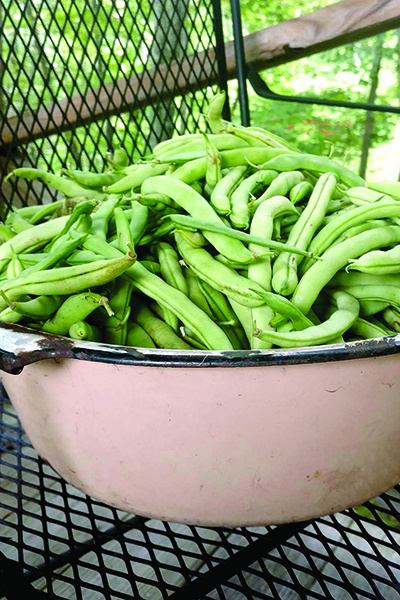
Her husband added, “We also started composting vegetable scraps, leaves, ashes from our wood burning stove and … coffee grounds. We would till that into the soil too as another way of being an additive. Between that and the chickens, it’s improved our garden spots up here a lot.”
The joy of homegrown eggs
The family’s flock of one to two dozen laying hens also contributes by providing fresh eggs. The Sullivans enjoy keeping a variety of breeds so they have a rainbow of different eggshell colors.
“People can grow pretty flowers and enjoy those, but I just have to have pretty eggs,” Sabrina laughed. “We search color first when we are looking for chickens … We choose to just find joy in the little things. You can go to the store and buy your eggs … but how much more fun is it to open your refrigerator to fix your breakfast and you’ve just got these beautiful eggs that you’ve gone out and harvested. It’s little things you can smile about all day long. Some people think, ‘Why go to the trouble?’ but it really is just little ways to have joy when everything else around you is harsh.”
Home-raised meat
In a further effort to take control of their food sources, the Sullivans also raise their own meat chickens. By doing so, they can ensure that the birds are raised on fresh grass and non-GMO feed and have the opportunity to forage naturally for bugs.
“We really want to get to the point where we’re not having to buy chicken from the store, and we think that doing 50 birds would come close to that for us,” Sabrina said.
Each year they move closer to this goal. This spring, the couple plans to get 65 chicks and will schedule their arrival and harvest around Joey’s schedule as a local math teacher.
When they started out processing their own meat birds more than 10 years ago, the couple would spend two long days each spring working up a total of 25 birds.
“Our table was two sawhorses with a piece of plywood, and I’m saying this to say that you don’t have to start out spending tons of money. If you’ve got the passion or desire, the rest will follow because the reward does keep you going to do it again the next year,” Sabrina said.
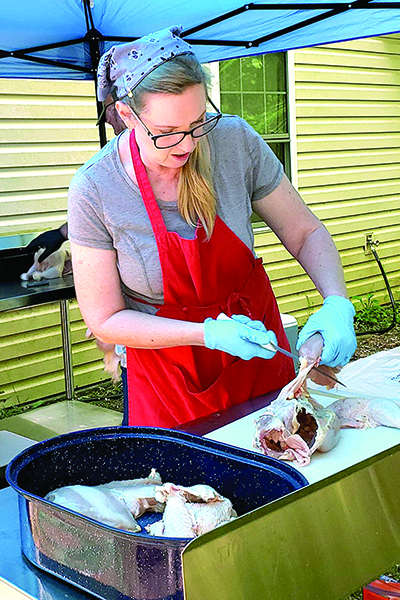
A few years back, they went in with some other homesteading families to purchase a chicken plucker, which made “a huge difference” in processing the birds, Sabrina said. Indeed, instead of taking 20 minutes to pluck each bird by hand, the machine now allows them to remove the feathers from two birds in less than a minute.
She recalled that doing everything by hand “was long and it was hard, but it grew a deep appreciation. You just rejoice when you get to do it the way we do it now because we’ve done it the hard way, and we did it that way for years.”
Another thing that has made the process easier is following the old adage, “Many hands make light work.” Last year, four families came together to help with the processing. The scene was reminiscent of an old-fashioned barn raising or quilting bee, as the helpers gathered around the scalding pot and arranged chicken breasts, thighs and wings into freezer bags. In an effort to try to cut down on waste as much as possible, the Sullivans even save the leftover carcasses and pull them out during the winter months to make their own chicken broth.
Joey and Sabrina appreciate the help of their family and friends and also see the experience as a teaching opportunity to help those interested in learning about raising their own meat birds.
“Some people we’ve turned on to it; some people we’ve turned off to it by letting them come and participate, but we usually try to send home a bird with whoever comes and helps,” Joey said.
“You grow the community when people have the confidence to try,” Sabrina added.
Given the challenges of those first few seasons of doing everything by hand, Joey admitted that, he is a bit amazed that they are still raising their own meat birds, but he is excited to see the transformation that has taken place in their own role in the process.
“We went from not knowing anything … to where we’re sharing the experience with people who want to experience it. Going from not knowing to being teachers of it, that’s a process I would not have seen happening when we started,” he said.
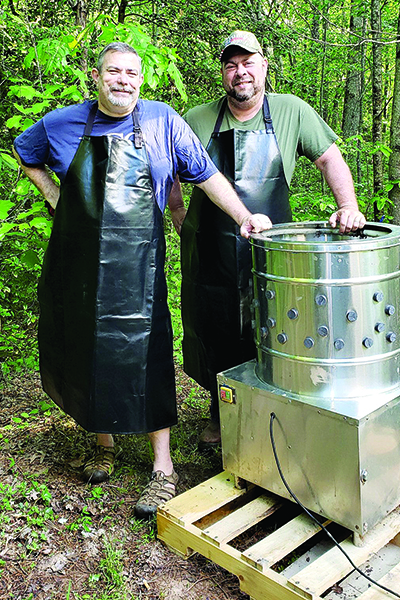
Gardening resources
In addition to poultry, the Sullivans work about a quarter of an acre of garden space along with Sabrina’s parents who live next door.
With each passing year, they are excited to see the results of their efforts to build the soil with the help of the chickens, and soon they hope to expand the garden to the area where the chicken tractors have been working the last three or four years.
Highlights of their gardening efforts include heirloom blueberry bushes from Sabrina’s grandmother’s property and how the picking, stringing and canning of green beans becomes a chance to spend time with family and build memories together.
When it comes to growing things for the garden, however, Sabrina admitted, “I don’t have a good green thumb. In fact, I’ve killed more plants than I’ve ever kept alive … There have been times when I’ve been real discouraged about it because the desire is so strong in me.”
For those who feel the same way, she offers these words of encouragement, “I believe that your passion and your inspiration will eventually get you there. Don’t quit no matter how many times you fail at doing something. If it’s in you to want to do it, just keep trying. There’re so many ways to learn.”
Some of the couple’s favorite online resources are from Joel Salatin of Polyface Farms and Justin Rhodes of Abundant Permaculture. They also recommend doing research on YouTube, Pinterest and at the local library and watching the documentary The Biggest Little Farm.
“One really good resource that I think people miss is going to your farmers market,” Sabrina added. “People down there selling produce love to talk to you about what they do. They’re in your area. They’re not from a different zone. They are a wealth of information in helping you troubleshoot if you’re having issues, and you can get plants that have been started right down the road. They’re not going to have to acclimate.”
Joey also recommended visiting the Gilmer County Extension Office and doing a soil test. He also urges people not to be afraid to experiment and try planting different varieties to see what does best on their property.
Strengthening relationships, building community
One of Joey’s favorite aspects of having a home garden and raising chickens is that he gets to work alongside his wife of 25 years.
“Sabrina and I are getting to sit down and plan: What do we want to plant? What do we need to plant? How many chickens? … It’s a project where husband and wife are both in on it … With my regular job, I don’t get to share all of that with her, but with this we get to share it all and do it all together,” he said.
They also enjoy meeting likeminded people in the local community and getting to trade farming know-how and resources with other homesteaders.
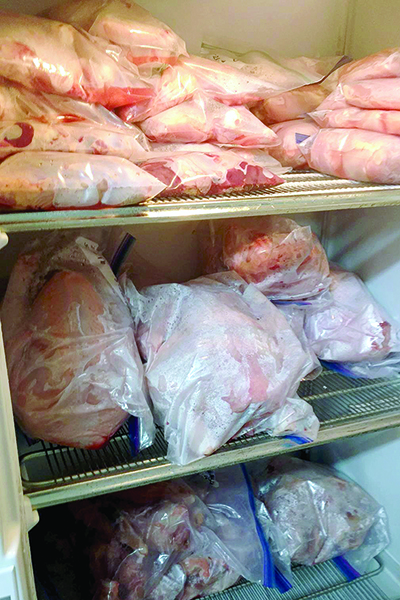
“The barter system works well,” Joey said, explaining how they were able to acquire locally-raised beef from some friends this year. “It’s using a lot of the methods that were used before we ever came along where people helped each other out. It does create that sense of community.”
Sabrina agreed that “you don’t have to do everything in one piece of property or even have a large piece of property” in order to have locally-sourced food.
Recently, a friend gave them the fat from one of the hogs they raised, and Sabrina learned how to render it into homemade lard. While she still has not made that “perfect pie crust” with it, all in all Sabrina is pleased with how the process went.
“I was expecting it to be hard and I was expecting it to make the house smell bad … It was really very simple. I was really surprised and I learned a lot,” she said.
The experience reminded her that “you don’t have to be an expert to try new things.”
As she urges those who are considering delving into gardening or other homesteading projects, “Just have an open mind and be willing to fail.” Sabrina also warned against setting yourself up for failure by thinking you are not good at something before you even try it.
“It’s OK if it takes years to develop some of those skills,” she said before describing how she takes lots of notes so they can improve their strategies from year to year. To help with the process, she recommends starting small with raised beds or pots on a deck and growing from there.
There will be obstacles along the way, such as trying to water animals in subfreezing temperatures, facing the premature loss of life in your flock due to feed issues or dealing with seedlings failing before planting season. But the rewards of becoming more self-sufficient are greater still. As homesteaders like the Sullivans attest, there are health benefits to be gained from raising your own food, as well as joy to be found from working alongside family and friends, spending time outdoors and learning new life-sustaining skills.
“If your interest is piqued (about homesteading) … see if there are any local people that you can glean from. And then if there’s not, use YouTube. Use Google. Look and see where you can find some resources so that you can become that person that others get to glean from,” Joey encouraged.
He went on to describe how the community at large benefits from this accumulated knowledge and how it prevents valuable life skills from dying out. He pointed out that there is no substitute for maintaining that personal human touch in your food production but concluded by admitting that some modern conveniences are certainly worthwhile.
“I will not give up the plucker,” he laughed.
(By Whitney Sherrill, Contributing writer, Home, Garden & Garage magazine 2021)

